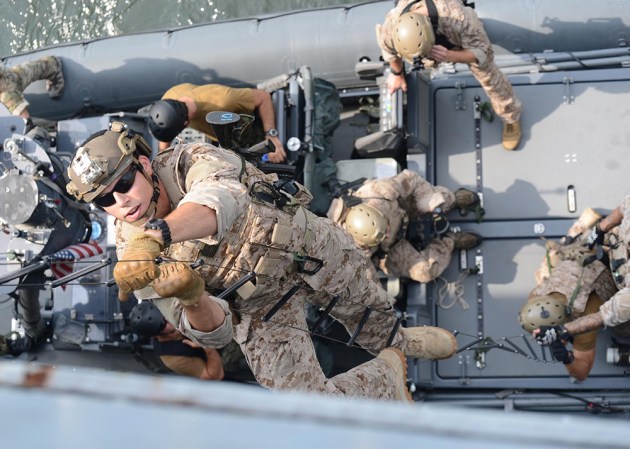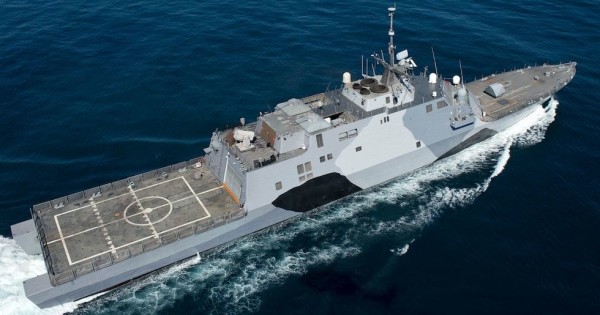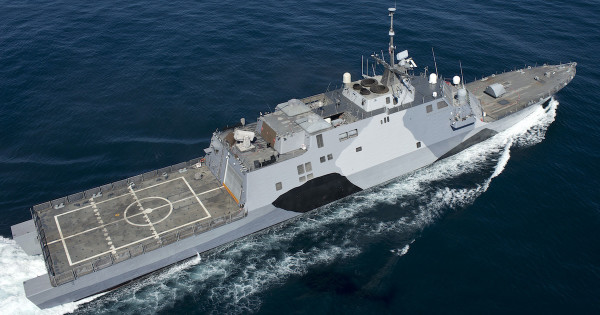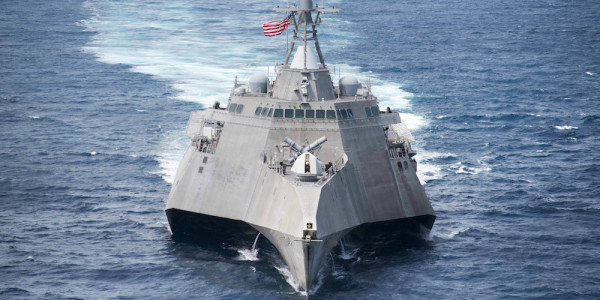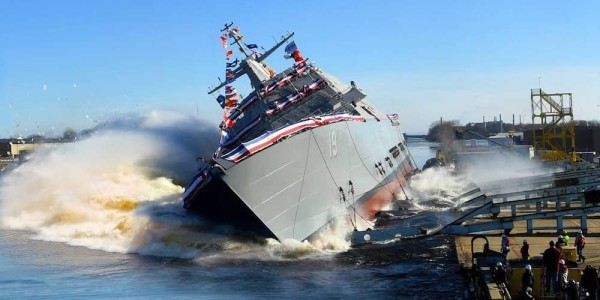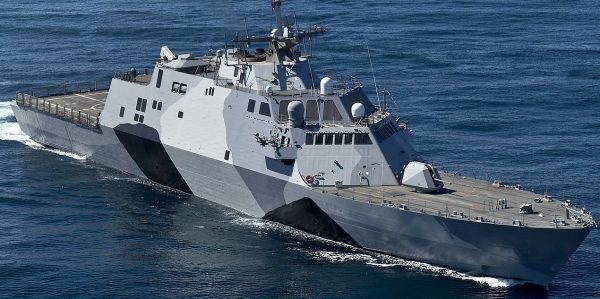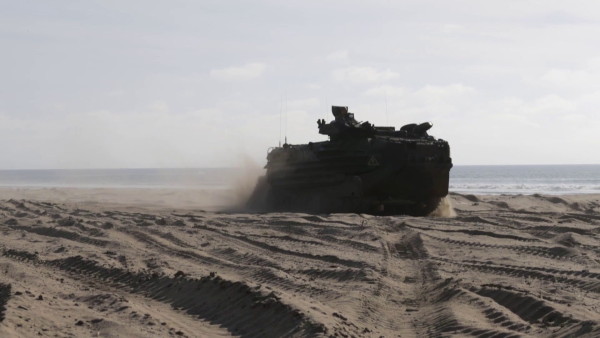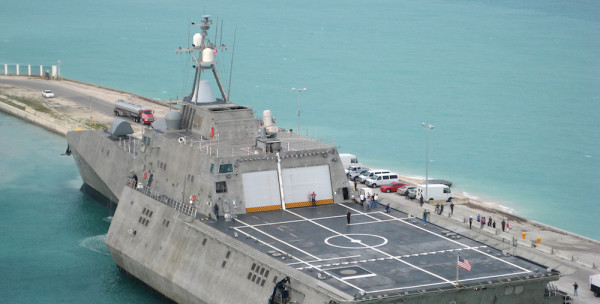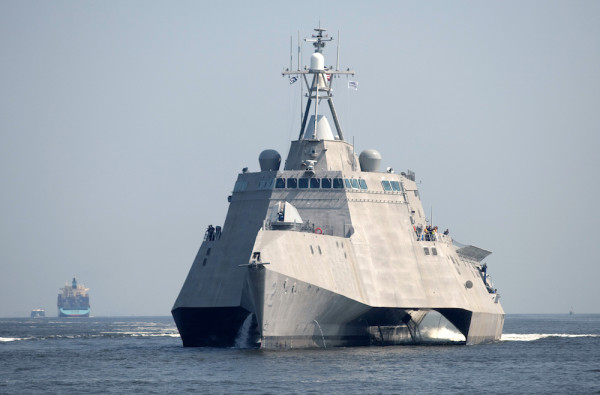Chief of Naval Operations Adm. Michael Gilday has suggested that the Navy dispose of the Littoral Combat Ships — which have earned the pejorative moniker ‘Little Crappy Ships’ — that it doesn’t want by giving them away as if they were inedible Christmas fruit cakes.
“We should consider offering these ships to other countries that would be able to use them effectively,” Gilday told lawmakers on Thursday.
Gilday’s suggestion came in response to questions from Sen. Jerry Moran (R-Kan.), who had asked if the Navy could find other uses for the nine Freedom-variant Littoral Combat Ships that it plans to decommission next fiscal year. Moran noted that one of those ships, the USS Wichita, was just commissioned in January 2019, and it recently practiced interdicting drug smugglers with the Dominican Republic’s navy.
“There are countries in South America, as an example – as you pointed out – that would be able to use these ships, that have small crews,” Gilday told Moran. “And so, instead of just considering scrapping as the single option, I think that there are others that we can look at, sir.”

It was not clear from Gilday’s comments whether he advocated selling the Freedom-variant Littoral Combat Ships or giving them away for free, but at this point, the Navy is one step away from hauling the nine ships out to the curb, hoping that someone will take them overnight.
Subscribe to Task & Purpose Today. Get the latest in military news, entertainment, and gear in your inbox daily.
The Navy expects to save about $3.6 billion in upgrades, repairs and retrofits, by mothballing a total of 24 ships including the nine Freedom-variant Littoral Combat Ships, which are among the newest vessels in the Navy. All have been commissioned since 2012 and the USS St. Louis isn’t even two years old yet. And that’s to say nothing of the fact that the Navy expects to spend more than $60 billion over the lifespan of the Littoral Combat Ship program, only to turn around and begin decommissioning the vessels once they’re in service.
But these ships have been hobbled by a design flaw that limits their speed. The coup de grâce for the Freedom-variants came when the Navy determined that they were not suited for anti-submarine warfare.
The Navy’s plans to decommission the nine Littoral Combat along with 15 other vessels have drawn sharp rebukes from lawmakers and navalists, who argued the Navy cannot afford to get smaller while China’s navy continues to grow.
During Thursday’s Senate Appropriations Subcommittee on Defense hearing, Gilday said the Navy is focusing on the quality rather than the quantity of its ships.

“We need a capable, lethal, ready Navy more than we need a larger Navy that’s less capable, less lethal, and less ready,” Gilday said
As the Navy prepared its most recent budget request, it looked at how well all its ships, submarines, and aircraft would do in a war against China, he said.
While the mechanical issues plaguing the Freedom-variant Littoral Combat Ships were a factor in the Navy’s decision to decommission the vessels, the Navy also found that these ships do not have enough combat power to fight against China’s People’s Liberation Army Navy, Gilday said.
“A key factor in the determination was the anti-submarine warfare package that was being developed for the Freedom-class hull that just were ineffective,” Gilday said. “And so, we refused to put an additional dollar against that system that wouldn’t match the Chinese undersea threat.”
However, the idea of giving or selling the nine Freedom-variant Littoral Combat Ships to other countries is facing some criticism. One of those critics is Rep. Rob Wittman (R-Va.), the ranking member on the House Armed Services Seapower and Projection Forces Subcommittee and co-chair of the Congressional Shipbuilding Caucus.
Wittman told Task & Purpose that selling the Littoral Combat Ships would be “a step in the wrong direction” because the U.S. Navy still needs the ships for surface warfare missions and other tasks.
“We know they are valuable assets for our combatant commanders in multiple theaters,” Wittman said. “I am particularly concerned about the Navy’s current divest to invest strategy that reduces force structure at a critical time in our strategic competition with China.”
The U.S. government may also face challenges if it tries to sell the Freedom-variant Littoral Combat Ships to other countries, said Blake Herzinger, a non-resident WSD-Handa Fellow at the Pacific Forum foreign policy research institute.
“First, I believe the initial proposal was a sale,” Herzinger told Task & Purpose. “I think we’d need a pretty good salesman to convince any country to buy a ship that the world’s most sophisticated navy has struggled to maintain and also openly called it ineffective for combat operations. Even if we were to provide these ships under our Excess Defense Articles program [at reduced or no cost], the level of long-term maintenance support required would be considerable. Most regional maritime partners likely wouldn’t be prepared to support the ship, and they’d become pier queens that just suck up limited budgets for our partners.”
Herzinger said he is concerned that by decommissioning the Freedom-variant Littoral Combat Ships, the U.S. Navy would fall further behind China, which already has the largest navy in the world and is expected to grow from 355 to 460 ships and submarines by 2030, according to the Defense Department’s most recent report on Chinese military power. In contrast, the U.S. Navy’s latest budget request calls for decreasing the fleet from 298 to 280 vessels by fiscal 2027.
It would take decades to catch up with China’s navy and there is no guarantee that Congress will provide the money needed to close the gap, Herzinger told Task & Purpose.
Herzinger also argued that navies do more than fight wars, and if the Freedom-variant Littoral Combat Ships are able to conduct drug interdiction missions, it is better to keep the vessels rather than scrap the ships and then wait for replacements.
“What we need is more budget, not cutting our fleet to find some spare change in the couch,” Herzinger said. “As a navy, we need to tell Congress what we need, how much it costs, and the risks inherent in trying to ‘do more with less.’ Congress seems to be anxiously awaiting that story, and increasingly annoyed that we’re dropping hulls, so let’s give them what they want – a shipbuilding plan that makes sense and a budget request that reflects our real needs rather than what we think we’re going to get.”
The latest on Task & Purpose
- An Air Force general wants to ‘robust’ Guam. What the hell does that mean?
- No, Hollywood is not required to screw up military uniforms
- SOCOM finally found its next-generation personal defense weapon
- How the myth that Mr. Rogers was a deadly military sniper began
- Sailors are deserting the Navy at a ‘staggering’ rate
Want to write for Task & Purpose? Click here. Or check out the latest stories on our homepage.






